|
Goat Agility - Obstacle Courses
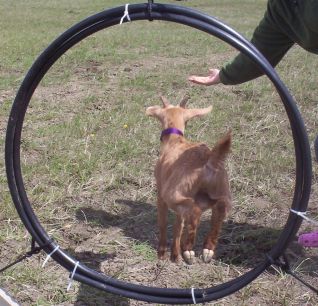
Goat Obstacle Course or Courses can be quite different then Goat Agility or a Goat Agility Course, but then again, they are quite the same too.
The equipment on an Obstacle Course and on an Agility Course can be quite different. Both are fun for the Goat, the Owner/Trainer and Spectators. Training for either or both however, is much the same...spend time with your goat working on many types of equipment.
This page is a work in progress, please check back for more ideas and to see photos we will be uploading. Thanks
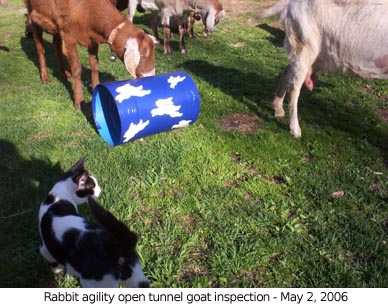
Yes indeed!! Just like dogs and cats and rats and hamsters, goats can and do run agility courses. At most Goat Shows and 4H shows it is called "An Obstacle Course".
Agility all started with Horse Steeplechase. Dog Agility was closely designed with Steeplechase rules and obstacles. All other agility was set after those. this is why you will hear the word "fences" used for the agility equipment, no matter what the jump or item or piece is.
Goats love to play and jump and learn, so it comes pretty easy to them. If you want to teach your goat to learn a course, it will take some work and patience on your part.
As you can see by the photo, my goats (animals) like to be with us, and in the middle of everything, so training them to agility pieces was/is pretty easy...keeping them out of the way while training other species (the photo is an Open Tunnel for a rabbit) is the hard part.
When entering into competition, please know the rules. Read and learn the rules before entering your animals into any competition.
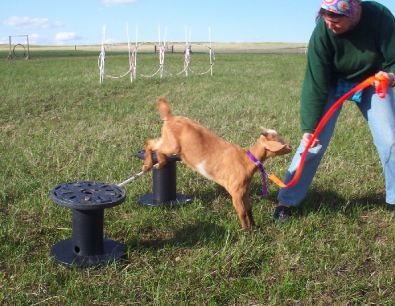
Your goat needs to be in good health and well groomed. Untrimmed hooves are not only unsightly, but could really hurt your goat's legs and feet if left untrimmed and manipulating pieces of agility equipment.
You may want to start your goat on a leash. It does not matter if your goat wears a collar or a hater, you are not going to/won't be able to, pull them over and through the equipment anyway. The leash is for guiding and encouraging the goat to come your way, or the way you are leading it.
DIFFERENCES BETWEEN GOAT AGILITY AND A GOAT OBSTACLE COURSE
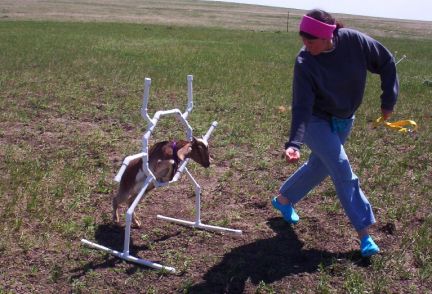
What is the difference between an Agility Course and an Obstacle Course? Well, many times, not much.
Ideally an Obstacle Course is a course set up of fun things for a goat to go over and through that a goat might see on the trail while packing or in the barn yard while out playing.
An Agility Course on the other hand is fun equipment that may or may not have anything to do with barn yards or trails or daily life.
Both courses are a lot of fun for both the boat and the owner. Learning to run either of the courses is a great bonding time for the animals and their owners too. PLUS the fact that audiences/spectators love this stuff!!
Adding either of these classes to a show or fair also shows the non goat people the intelligence of the goats.....some goats will have intelligence on the courses over even their owners!
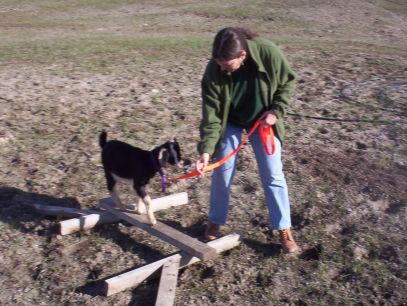
Of course the younger you start training your goat, the better. Once the animal has learned to learn the faster it will learn other things you are teaching it.
Bottle fed babies are of course easier to teach and work with then mama fed babies. However, you can teach an adult goat that was mama fed if you work with it correctly.
Always remember when training any animals, that each trainer and animal is different. Each person trains a little different even when training the same thing in the same way as another trainer. Each animal you train is an individual. You may be trying to train two goats at the same time, which by the way is a very good idea, not the exact time, they each need one on one training, but training two goats so that they can watch each other learn. Even two goats that are litter mates will learn differently, so you may need to train just a bit different.
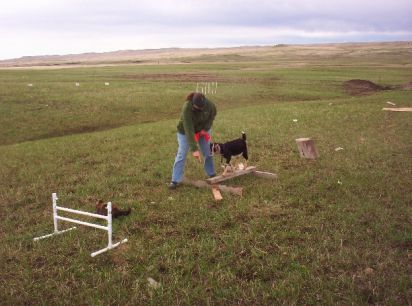
When training be sure to... Be patient. Be fair. Be nice. Stop before the goat gets tired or before you get frustrated. Be sure you are showing the goat what you want in small steps so that it can understand what you want it to do. Do more with your goats then just train, in other words, walk your goats, scratch your goats, spend time with your goats. Use small treats while training. Most of all, Have Fun and Be Safe.
Be sure to verbally praise your goat as they learn even the smallest point of your training. Step by step, little by little is the way to train animals. Break everything down to little steps, call them baby steps. Be sure to pet and rub your goat for praise also.
Whether you use verbal praise or a clicker, use it correctly and quickly. The moment that the goat makes the correct move. I prefer verbal training with treat backup. The treat comes with each step at first, then it becomes a use now and again with verbal praise and petting.
And I hate these, but for the stupid and for the greedy, here it is, our disclaimer:
These training tips are the way that my husband Deron and I have trained our own goats. They may or may not work for you. We can NOT be held responsible for the training or lack of your with you and your goats. Training animals can be dangerous and you should take all precautions. Children should not be expected to train their animals without adult supervision. You can get hurt training your goat, you could trip over a piece of equipment, your goats leash, your goat's foot or your own two feet.
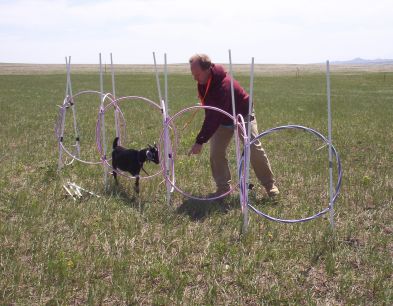
I can not stress enough that the equipment needs to be safe, meaning not only stable, but also no shape edges, strong enough to hold double the goat's weight you will be using on it, made well, etc. You can of course use some of your dog's Agility Equipment, depending on goat and dog's sizes, but be warned that hooves will tear some of the pieces up or scuff them up, where dog paws will not. That being said you might be surprised at what can become Goat Agility/Obstacle Equipment for the back yard.
Just because goats like to climb does not mean that your equipment should be too tall. Goat's are agile and love to play, but they do not land like cats. Depending on the goat's height, keep all your jumps just under their shoulder blade high. Remember, it is just as cute to see a goat jump 10" as it is to see them just 15".
Keep your Balance Beams low and stable as well as wider then a dog's would be. Your Tunnels will need to be at least as tall as your goats shoulder's and remember, the hooves will be hard on the fabric type.
Make your A Frame more like a peeked bridge then like the letter A. Goat A Frames will need to be very stable for the weight and the stride of a goat. Goats are not clumsy, but different then a dog for sure. You will also need the cross planks on the A Frame as well as a non slip surface. Hooves will slide more easily then paws, and when wet, you might double check the surface before sending your goat over the A Frame.
SOME FUN IDEAS FOR FREE OR INEXPENSIVE GOAT AGILITY EQUIPMENT
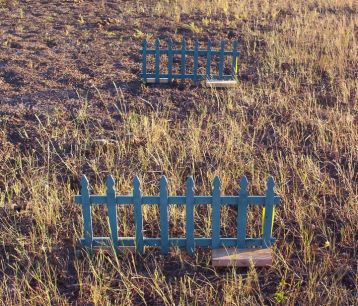
Most of your equipment, as with dogs, will need to be adjusted to the size of the goat that is using it. Some items can be the same size for the Pygmy as a larger meat or dairy breed, but other items, such as your tunnel, can be a bit smaller for the smaller breeds of goats, therefore easier to find, then a Tunnel for the bigger goats.
A couple of Cinder Blocks and an old broom might become a Jump.
The little fence jumps in this photo were purchased at a Hardware Store in the Lawn and Garden Dept. They were made for gardens, but great for Agility Jumps. We cut the spikes off the bottom of these and added flat 2" x 4" scrap pieces of lumber to the bottom so that the jumps could be moved and will also fall over if hit by the animal's feet.
That old left behind Hula Hoop or Bicycle Tire can make Hoop Jumps or call the tire your Tire Jump.
See that old plastic barrel? Can it be cleaned out? What was in it to begin with? If it was soap you can rinse it out and cut off both ends for a short Open Tunnel.
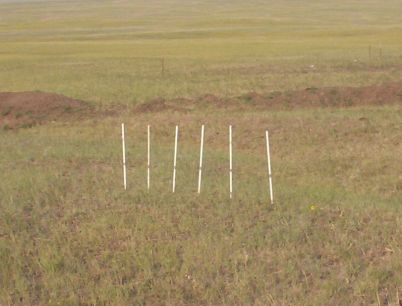
Stop in that local Car Wash and ask what they do with their plastic barrels when empty (most give them away so they do not have to pay to send them back or to the dump)
Hardware Store for 1" plastic conduit to be cut and used for Jumps or stuck in the ground for Weave Polls, kinda like the ones in the photo.
Do you have any trees on your property or know someone that does? Or do you have a firewood pile? A log cut to approx 28" - 30" would make a pivot for a 2" x 10" x 8' board for a Teeter Totter. Just choose the size log you would like to have and screw the board to it.
Two logs approx the same size with another 2" x 10" x 8'board would make a great short Balance Beam.
VISIT GARAGE SALES, FLEA MARKETS AND THRIFT SHOPS You might be pleasantly surprised at the items you might find at second hand shopping areas. Never over look the toys sections and be sure to go through those boxes, many, many many great goat agility items as well as trick props can be found for not much more the .25.
Items you might find:
Child's Collapsible Open Tunnel
Human toddler's plastic slides
Plastic Club Houses (great to teach the animal to go in one way and out another)
Hula Hoops
Small Car Tires (usually free)
A Scooter (for cross training)
A child's wagon, they come in many sizes one for all goat's sizes <grin> (for the goat to pull for cross training) BUILDING YOUR OWN GOAT AGILITY EQUIPMENT
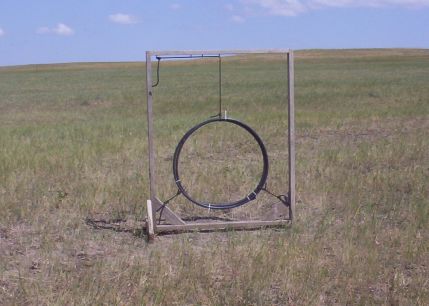
Building your own equipment is fun and exciting and can save you a lot of money while allowing you to own more equipment then if you had to purchase each piece.
I can not stress enough how important it is for each piece to be stable and well built, wide enough for the animal to run safely on, as well as have no sharp sides, or screw or nails sticking out, not even under the piece.
For goat equipment you will need to add Non-Slip paint to the surfaces. Hooves will slip more then dog paws will.
On the A Frame you will need cross lumber pieces as well as make the item very stable and add a non slip surface cover to the surface for the safety of the goat.
PVC can be great for making jumps. But you will need a good grade lumber, preferably pressure treated, for A Frames, Balance Beams, Walk Overs and other pieces the goat will walk on. These items will need to be lower to the ground, more stable and perhaps wider then dog equipment for most goats. Goats have a different stride as well as body type and also carry their weight different then a dog does.
Keep in mind that it will be hooves going across the equipment not paws as in dog agility equipment. There is a big difference. While dog toenails can piece fabric items such as Tunnels, goat hooves probably will. Dogs feet can become slippery when wet, goats hooves are very likely to be. Paws and Hooves, very different.
The Tire Jump we made in this photo is not made crooked, the horizon is on a hill. LOL It makes the Jump look cockeyed.
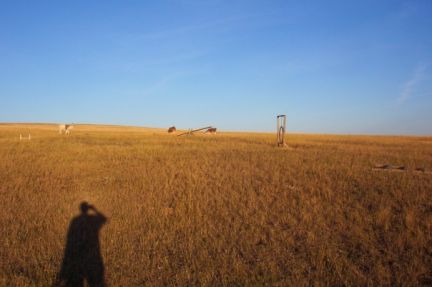
Your training area needs to be as flat and even as you can find. Holes for the goat and or you to fall in do not have to be explained....the same goes for rocks in the area for you to trip on.
If you have an area that is barren, all the better...your goat will not be distracted by a clover leave tempting it.
An area as big as you can find is best of course, but even a small area can be used for your training area. Just make sure that the pieces of equipment are set up far enough a part as to not wear out or strain your goat's muscles.
You also need to keep the area nice. Keep the grass low, keep poop picked up, keep wear areas covered, ect. This helps keep the area safe for your and your animals.
TRAINING THE AGILITY PIECES
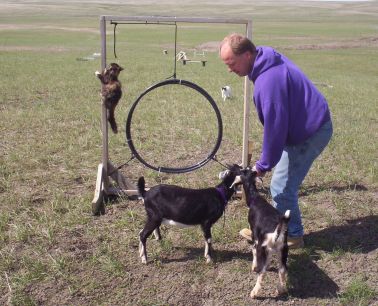
Goats are adventurous and love to jump, run and play, so it is really east to teach them to enjoy an agility course with you. You might even find your goat out on the pieces, if it has access to the course, without you.
Teach your goat one or two pieces of equipment at one time. Do not try to run the goat through the full course before showing the goat the safest way to manipulate each piece. We started with one piece, the pedestal, then added another, then the third piece and so on. Add your pieces behind or in front of the pieces that the animal has already learned. That way it is either, new piece, familiar pieces; or familiar pieces then a new piece.
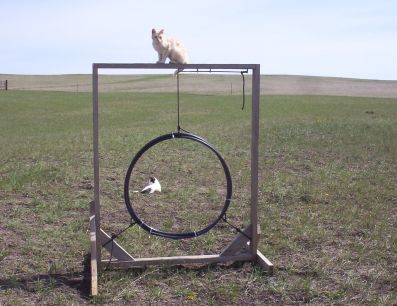
You might even teach the new piece away from the rest of your course. Add the new piece into the course after it is well learned and the goat is coming over, under or through it easily.
As you can see from the photos, each with two kitties in them, that everyone gets a kick out of watching goats enjoy the agility pieces (and our cats as well as other animals, follow us everywhere LOL)
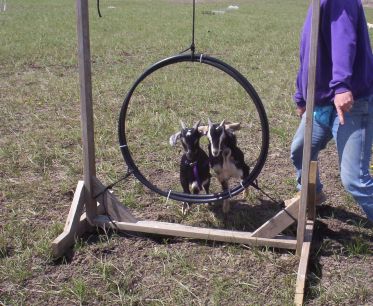
This double goat jump was actually an accident the first time through. You gotta love a goat that loves the equipment so much that they just can't wait to do it again, even if it was not their turn.
This is Noah and Micah who will jump through together any time you ask them to. The problem will come as they grow, and no longer fit. I must admit, larger jumps came to mind. Goats sure make life fun and exciting.
JUMPS
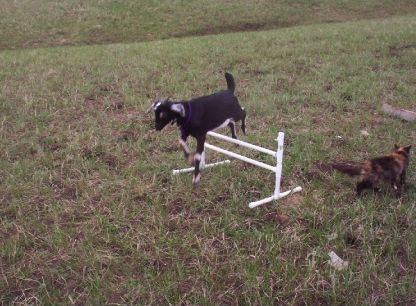
Jumps do not have to be set at a high height for goats. When starting out keep jumps low to encourage the goats to come over easily.
Bar Jumps should have break away polls so that if the goat should "hit" the top bar it falls away without tripping or startling the goat.
Jumps should also be set at least 12' apart for the average dairy breed goat.
To teach your goat the jumps, have the goat on leash as it stands on one side on the jump, with you on the other, and give the verbal cue (I use "jump" for regular jumps and "through" for hoop jumps) as you show the goat a treat just our of it's reach. Goats love jumps so it won't take a lot of coaxing from you. Step back to make sure the goat has plenty of room to clear the jump, have the goat take a couple of steps forward after the jump, then verbally praise and treat the goat. Repeat for a few sections like this then see if your goat won't take the jump as you walk or jog up to the jump with your goat. You can go over the jump with the goat or just off to the side of the jump.
At this point you could also add another jump about 12' behind the jump the goat just learned. (set it up so that the goat does the jump you just taught it first, then the new jump)
WEAVE POLLS
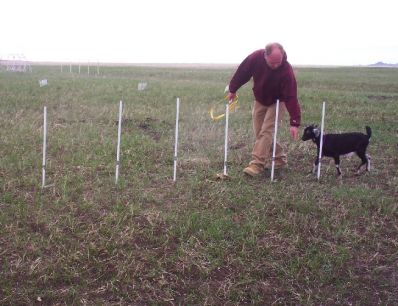
Weave Polls can be wooden dowels or plastic or PVC polls or tent polls no longer needed for that torn up tent, that are anywhere from 3' - 5' high from the ground. They should be set approx. x' apart.
Most goats will follow a hand for a treat, making hand cues quite easy. I stay on one side of the polls as I have the goat on leash and as weave my hand around the Weave Polls as I give the verbal cue "Weeeeeave". I have the goat step out about three to six steps from the Weave Polls before giving the treat. Be sure to use a very encouraging voice as the goat Weaves the Polls.
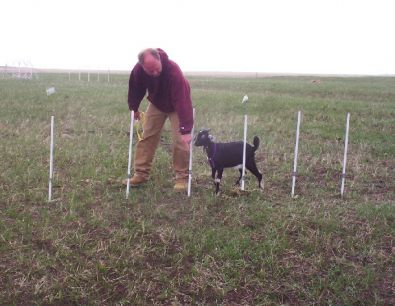
Deron, my husband was working Micah for the first time on the Weave Polls and I heard Deron say as he treated and praised Micah after he weave the polls "You did not even notice the polls there, did you buddy?" I had to laugh, but the truth is that goats are very intelligent and yes, they do notice that they are weaving, I know that because the next few times go very easy after training this and soon the goats know to weave the Polls when they see them.
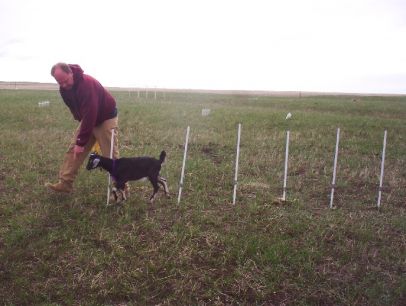
When your goat is weaving the Polls well, try just walking with the goat and see if it does not weave them on command....have that treat ready when the goat comes to the end.
PAUSE TABLE
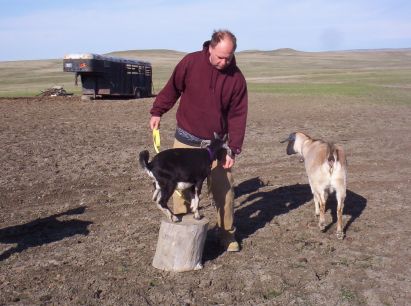
You can use so many different things for the Pause Table for a goat. We use a large tree stump. A Pedestal makes a really nice Pause Table for the goat and the goat also will learn that the Pedestal means a trick or something is about to happen.
Your Pause Table needs to be very stable and large enough for the goat to stand on with room to move around. The table does not need to be very tall off the ground. Six to eight inches high is high enough. If you are going to use a taller Pause Table, start training with a table that is close to the ground.
The hard part of this piece will be to get the goat to stop and wait for your cue to move on. Getting the goat to jump up on the table will be easy.
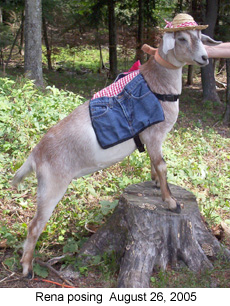
When you first start the Pause Table or Pedestal do it alone and away from the Agility Course. Train the goat to get up onto the Pedestal and wait. At first you will have the goat stand in front of the Pedestal on the opposite side as you are on. Hold a treat over the middle of the Pesestal and tell the goat your cue word, I use "pedestal". As the goat reaches for the treat move it slowly away from the goat so that the goat has to step up on the pedestal. At first if the goat is slow to step up, treat the goat as it stands with just it's front feet on the pedestal. Then get another treat an move it further out so that the goat has to move forward, most will step up with back legs. If you goat starts to get off with it's front legs be prepared to block it with you lower body so that it steps up, but not off. Reward with verbal praise and a small treat. Stand in front of the goat for a moment so that it can not jump down. The idea is for the goat to stay on the pedestal until told your cue word (we use "off") then encourage the goat to get off and yes, give another treat for this cue....goats catch on so much better with treats when you first begin training.
TUNNEL
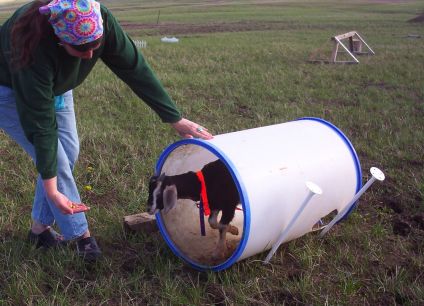
Finding a Tunnel that is tall or has a large enough diameter for a goat as well as made of a material that will hold up under goat hooves will not be an easy task. Many people do not have Tunnels for their goats for that reason.
I am using a 55 gallon barrel with both ends cut out. I am hoping to use two or three of these put together.
Training the goat to go through a Tunnel will not be too hard. If the Tunnel will shorten in length (as in according type tunnels that fold down) make it short and start with a human helper.
Have your helper hold the goat at one end of the Tunnel. You go to the other end and bend over with your face and treat held so that the goat can see both. Call the goat. Most will come right through the Tunnel.
If your goat does not come right through the Tunnel.... standing at the same side as your goat, toss a treat into the Tunnel, when the goat goes in to get the treat move to the other end and call the goat through.
Repeat this until you can send the goat through the Tunnel on command.
TIRE/HOOP JUMP
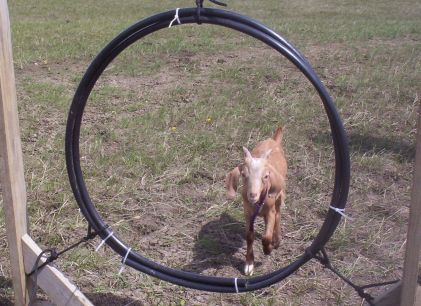
A Tire Jump for a goat needs to be large enough for the goat to come through easily, maybe more of a Hula Hoop Jump. Your stand will need to be very stable especially if your goat has large horns. Most goats will readily jump through the mounted hoop without hesitation. As always train with a treat and lots of verbal praise.
Hold the treat on the far side of, or opposite your goat, the mounted hoop and encourage the goat through with a treat. Give a verbal command that you will use for the Hoop Jump each time. We use "though the hoop". When the goat comes through the hoop praise verbally and give the goat a treat.
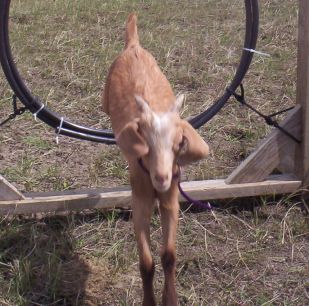
If your goat has a leash on it will be easy to hold the goat in place on one side as you step over to the far side. The leash may also be used to encourage the goat to come through to the side you are in.
Step back as the goat comes through the hoop to give it room to land. Have the goat take a couple of steps before receiving it's treat reward, praise however as soon as the goat comes through the hoop. Repeat until the goat is coming through quickly then try to walk up to the hoop with your goat and send it "through the hoop" with your verbal command as you walk by the hoop next to your goat.
BALANCE BEAM - DOG/GOAT WALK
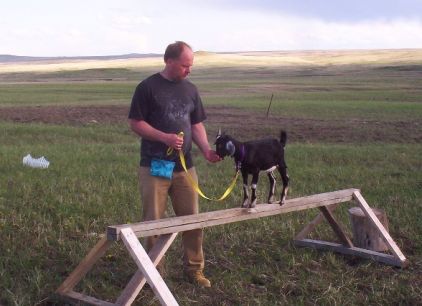
This can be a lot of things. It can be wide, or narrow, but certainly a piece that you do not hurry a goat across. If it is a Balance Beam it will be thinner in width then the Goat Walk, that is made more like a Dog Walk for dogs in Dog Agility.
To train for this piece you will start low and wide.
much more to come
TEETER TOTTER
Teeter Totters are a bit lower then a Sea Saw. A Teeter Totter is usually a long board set on a log type pivot, a Sew Saw is a board set on a higher A Frame type pivot, both are taught to the animals the same. However, if you have both, teach the Teeter Totter to the goat first.
I know many people that work with goats on Agility Equipment also work dogs. But goats need different equipment then a dog does. the Teeter Totter and Sea Saw is one on those pieces where this will really matter.
A goats Teeter Totter or Sea Saw need cross boards. Cross boards are those little pieces of boards, about 1" tall, that go cross ways on the Teeter Board so that the goat does not slide with it's hooves. The cross boards need to be about 12" - 18" apart and run from on end of the Teeter Board to the other.
A Goat Teeter Totter also needs to be wider then a dog's Teeter or Seasaw would be. The goat has a wider body base and different stride then a dog.
more to come
A FRAME
A Goat A Frame will also need to have cross boards set at about the same distance as they are on the Teeter Totter for the goat. Most dogs do not weigh as much as a dairy type goat so be sure that your A Frame is sturdy enough for the goat's weight. Your Goat A Frame also needs to be VERY stable and wide. The angle of the A Frame may be set lower then it would be for a dog.
Teaching the A Frame to the goat should be very easy! Goats love this sort of thing and if this piece were in their goat pen, it would probably be one of their favorite toys!
more to come
SETTING UP YOUR COURSE FOR THE GOATS
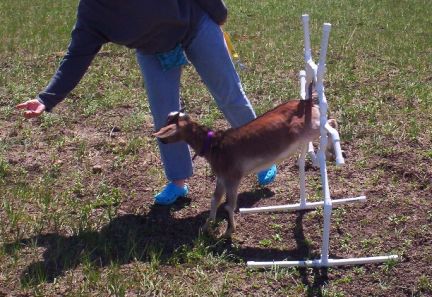
When setting up your course keep in mind that the goat will need some room between each piece for striding. You pieces for a goat will need to be set up at further lengths then for a dog.
Make your course fun and non tedious for your goats. You do not want to have jump, jump, jump, jump. You might set it up to be a Jump, Teeter Totter, Jump, Weave Polls, Jump, Jump, Tunnel. If you shake it up a bit, not only will it be more fun for the goat it will not wear them out.....jump, jump, jump, jump can be tiring for animals.
A Hoop Course can be a lot of fun to teach and to watch an animal do. A Hoop Jump is a Hula Hoop sized (or there abouts) Hoop that can be mounted in several ways, but usually are set near the ground within a three sided very simple PVC stand or on one or two 2" x 4" or 2" x 6" stands that connect only at the bottom of the hoop for stability.
The Hoops are set as far or near as the course designer chooses and can be set in a straight line or curved, S-Shaped or in a almost closed circles. Think of the individual hoops as a big slinky that a goat can run through.
You can use 1" black plumbing hose. It is easy to work with and inexpensive to buy. You can make your hoops any size you choose. Cut wooden dowels about 3" - 4" long to fit inside your hose at both ends of your hoop for stability and helping to hold the hoop together for years to come.
You can leave your Hoop Jumps black or decorate them with colorful tape or fabrics. After your goats learn to run through the Hoop Jumps you can add streamers from the top of them and cover the last one with paper for a TA' DA' ending to your course.
To teach your goat to come through a covered hoop.... first teach it to come through the hoop for a treat. Then have plenty of newspaper and tape on hand. Add just a strip of newspaper to each side of the hoop. Tape paper to paper, not to your hoop. After your goat comes through the hoop with the newspaper strips on each side add a strip of newspaper to the top and bottom of the hoop, again, tape paper to paper, not to your hoop. After your goat comes through that add a little more paper. Make a big fuss each time the goat comes through the covered hoop. Keep closing the hoop off with more and more newspaper, however leave a hole in the middle about 3" so the goat can target that space. Now when you do this as a show off trick, you tissue or wrapping paper or paper you have written on that says, THE END or TA'DA or the like.
You can use Hoops in a course of their own or add to any type of Goat Agility Course.
TRAINING FOR AN OBSTACLE COURSE You might find any or all of the above Agility Pieces of Equipment on an Obstacle Course, but more likely you will find.....
THE TARP
The tarp is usually a typical blue tarp. It can be hanging or flat on the ground. If it is hanging your goat will need to learn to walk through it, as in have it touch their face and body as it flows over them as they walk calmly under it.
If it is on the ground, the goat is expected to walk right up on it and walk calmly to the end and off the tarp.
Sounds so easy.......believe me, practice both of these scenarios in the wind and see how it goes.
You can hang a tarp or part of a tarp from a child's swing set...remove the swings first of course. Stand on the far side of the tarp and call you goat. Have a leash on your goat. If the goat does not come to you or goes around the hanging tarp to reach you, start again. This time shorten the leash on your goat and call the goat, only lift the tarp so that the goat comes under it and gets a treat. Repeat this three times and then on the forth time, do not lift the tarp. I am betting most, if not all, goats will come to you quickly.
You should also walk with the goat under or through the hanging tarp. Try not to lift the tarp but to duck underneath it. Make sure you verbally encourage and praise your goat as it works with the tarp.
Practice also with a tarp on the ground. Simply lay the tarp down and walk your goat over the tarp. Most goats will not have a problem with this obstacle once they have walked over it once. I was serious about practicing the tarp obstacles on a windy day. It will make a difference. And you never know what the weather will be on show day.
THE WATER PUDDLE
The water puddle can be a real puddle, depending on the weather or if there is a hole and hose around; it can be a child's wading pool, or a tarp in a depression in the ground with water added.
Many times the goat owner will have to walk through the water with their goat.
If you have a child's wading pool try adding just an inch into the pool and walking the goat through it. If you do not have a pool....wait til it rains and get out there and find a puddle. Some goats love to play in water....but most will not. So you want to be sure you have your pockets full of treats to train this one.
THE HORSE TRAILER
If you own a horse trailer or big box practice loading and unloading your goat into it. You may be asked to send you goat in, but most of the time it is a "follow you in" kind of obstacle for the goat.
This is pretty easy with a goat that walks with you well. Most goats will go right along with you. Truth is, most goats are nosy and would go into an open trailer on their own just to see what is in there. LOL And if you are having trouble getting your goat into the trailer....just use treats to lure it in with your going in too.
THE LOG JUMP
Usually made with a real log, or a pile of brush. But can also be a pyramid of large PVC pipes cut to 4' lengths. The goat just needs to hop over it. There may or may not be two or three of these in the course.
This is very easy to teach a goat. If you do not have the jumps set too high or too wide, your goat will hop right over them as you walk the goat to and over them. You might want to raise the height and widen the width after the goat is jumping them well. If your goat should refuse to jump over your jumps, jump with it. Keep it's leash short so that it is right beside you and just hop over the jumps. Of course you should verbally praise the goat any time it behaves in the way or preforms as you are asking it too.
WEIRDO WITH A DOG
OK, here's a good one. This is usually a person dressed as a clown in very loud clothing walking a small dog. The dog may or may not bark at the goat. The goat is expected to walk by the dog and weirdo.....not run from or not go up to them.
To train for this you need to have someone, friend or family, dress weird and love on or at least come around your goat while you are working with it on the other obstacles. If you do not make a big deal over the person dressed weird, your goat probably won't either.
STREAMING TUNNEL
This is usually a PVC Tunnel built tall enough for a person to walk through, about 6' long with streamers of one type or another hanging to the ground. The goat is suppose to walk through without fear or without messing with the streamers.
You can train this at home with a hula hoop and cheap plastic ribbon. the easiest way is to teach your goat to jump through the hoop (see our tricks page) then add the streamers (also on the trick page) to the hoop and have the goat jump through the hoop of streamers. After your goat will do this add longer streamers to the hoop and have someone hold the hoop or hang the hoop so that you can walk with your goat through the streamers.
Or, you can hang streamers of one sort or another, from a child's swing (with the swings removed) and walk your goat through.
PACKING GOAT OBSTACLE COURSE SET UP You might set up a Packing Goat Obstacle Course a little different then a course set up for goats without packs. You will need to remember that their packs will stick out to the side further then the goats that are not in packs.
more to come
HARNESS GOAT OBSTACLE COURSE SET UP Many times an Obstacle Course for harness animals is mostly set up with orange traffic type cones. It will involve manipulating around cones set up for the harnessed goat to pass to the right and to the left of the orange cones. The goat might also have to back up into or within a set of cones with 3 or 4 cones set parallel on two sides giving the goat plenty of room to make small mistakes.
more to come
STARTING A GOAT AGILITY GROUP IN YOUR AREA To start a group is not as hard as one might think. If you own a goat and know other people in your area that own, show and or breed goats, you are on your way.
Talk to them about the sport and show them a website or video or other information you might have.
Pick a place and time. I found a city park is a wonderful place to set up. Choose a time, week day evenings with the promise of a bite to eat after, might be your best bet. You won't be out there during the winter, so you will have light until 9pm or so in most areas of the country.
You will need to furnish some sort of equipment for the group or individuals you will be inviting. You can make some pretty easy and inexpensive pieces with little knowledge of tools. If you have three or four pieces (more is better of course) that will be a great start. You will find that once people start coming and enjoying this sport with a group, they will also build and bring equipment.
As people arrive greet everyone and meet their animals. Introduce everyone, even if you forgot their names....ASK them again and introduce everyone. People are more forgiving of you forgetting their names, but not ignoring or not introducing them to others.
If you are a 4H Leader you may want to introduce Goat Agility to your Goat Group. The kids will love this sport and if treated correctly, so will their animals!
You may need to approach a 4H panel before starting something like this with your group, or you may not. If you do you will want to have much information with you before the meeting. Be sure to take your ideas for how much room you will need to set up, what equipment you will need and where you will get it from, if you will have special training times for the kids, and any information you can give the parents to take home and go over.
Once you get permission from the powers that be, you will need to talk up the sport to the kids. Try to be informed before having your first meeting with them.
It is always a good idea to have times set for folks. It is a good idea to start or be there on time every time, if you are early you can get set up. You should also have a stopping time. About an hour and a half is perfect. After the event you might have a standing invitation for everyone to go to a Fast Food Restaurant, Dutch Treat (everyone pays for their own meal). That way you can bond more with the people that were concentrating on their animals at the practice. You can talk animals and agility as late as you like or leave early.
Always remind everyone when the next practice will be that evening and call them the day before the event when the date rolls around.
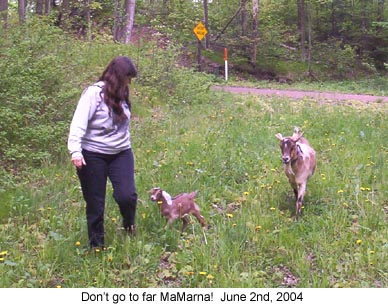
If you are going to compete, you will need every edge you can get. Cross training is a great way to train for an event. The idea is that the animal will continue to work, continue to spend time with you, continue to exercise, but not get bored or injured doing the same thing over and over and 0ver.
What is cross training? It is getting out with your animal doing something else rather then training on the activity that you are focusing on. ie, for goats? Pulling, packing, hiking, tricks, and the like.
AGAIN, WE WILL BE ADDING TO THIS PAGE MORE INFORMATION AND PHOTOS AS WE GO, PLEASE CHECK BACK OFTEN
| 



 In the high plains of South Dakota, USA
In the high plains of South Dakota, USA In the high plains of South Dakota, USA
In the high plains of South Dakota, USA